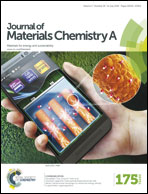Efficient polymer solar cells based on a copolymer of meta-alkoxy-phenyl-substituted benzodithiophene and thieno[3,4-b]thiophene†
Abstract
A new conjugated copolymer, PBTF-OP, based on meta-alkoxy-phenyl-substituted benzodithiophene (BDT-m-OP) and 2-ethylhexyl-3-fluorothieno[3,4-b]thiophene-2-carboxylate (TT) was designed and synthesized for application as the donor material in polymer solar cells (PSCs). PBTF-OP possesses a similar molecular structure to the well-known polymer PTB7-Th but different conjugated side chains on the BDT unit: meta-alkoxy-phenyl side chains for PBTF-OP and alkylthienyl side chains for PTB7-Th. Compared with PTB7-Th, PBTF-OP exhibits absorption with some blue shifts, while it possesses a deeper HOMO energy level of −5.45 eV and a slightly enhanced hole mobility of 1.25 × 10−3 cm2 (V−1 s−1) versus a HOMO energy level of −5.30 eV and a hole mobility of 1.11 × 10−3 cm2 (V−1 s−1) for PTB7-Th. The PSCs based on PBTF-OP:PC71BM showed a higher power conversion efficiency (PCE) of 9.0% with a higher Voc of 0.86 V in comparison with a PCE of 8.3% and a Voc of 0.78 V for PTB7-Th. The results indicate that side chain engineering of BDT-based copolymers is an effective way to improve photovoltaic performance of polymer donors.
![Graphical abstract: Efficient polymer solar cells based on a copolymer of meta-alkoxy-phenyl-substituted benzodithiophene and thieno[3,4-b]thiophene](/en/Image/Get?imageInfo.ImageType=GA&imageInfo.ImageIdentifier.ManuscriptID=C6TA04030F&imageInfo.ImageIdentifier.Year=2016)

 Please wait while we load your content...
Please wait while we load your content...